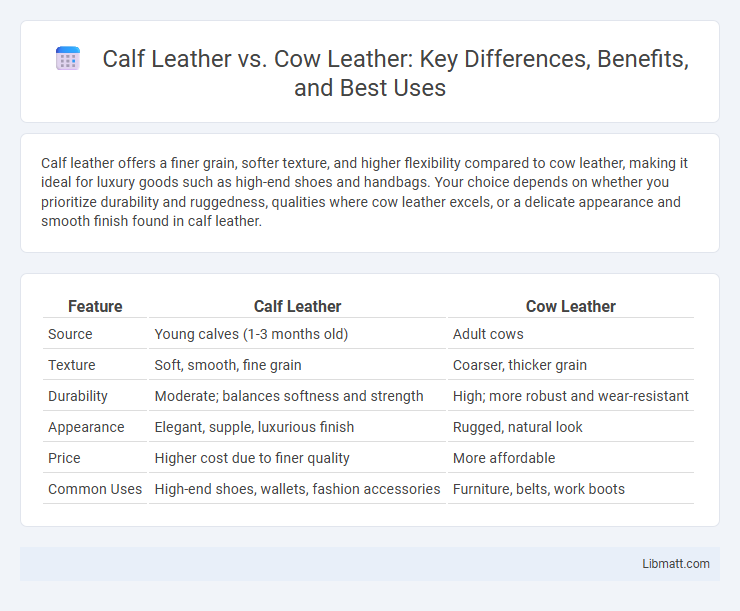Calf leather offers a finer grain, softer texture, and higher flexibility compared to cow leather, making it ideal for luxury goods such as high-end shoes and handbags. Your choice depends on whether you prioritize durability and ruggedness, qualities where cow leather excels, or a delicate appearance and smooth finish found in calf leather.
Table of Comparison
| Feature | Calf Leather | Cow Leather |
|---|---|---|
| Source | Young calves (1-3 months old) | Adult cows |
| Texture | Soft, smooth, fine grain | Coarser, thicker grain |
| Durability | Moderate; balances softness and strength | High; more robust and wear-resistant |
| Appearance | Elegant, supple, luxurious finish | Rugged, natural look |
| Price | Higher cost due to finer quality | More affordable |
| Common Uses | High-end shoes, wallets, fashion accessories | Furniture, belts, work boots |
Introduction to Calf Leather and Cow Leather
Calf leather comes from young calves, offering a fine grain, smooth texture, and superior softness compared to cow leather, which is derived from mature cows and tends to be thicker and more durable. The higher collagen density in calf leather gives it enhanced flexibility and an elegant finish, making it ideal for luxury goods such as high-end shoes and handbags. Cow leather's robustness and resistance to wear make it preferred for heavy-use products like boots, belts, and workwear, providing longevity and strength.
Origin and Source: Calf vs Cow Leather
Calf leather originates from young calves, typically under six months old, resulting in a finer grain and softer texture compared to cow leather, which comes from mature cows and is generally thicker and more durable. The source affects the leather's quality, with calf leather prized for luxury goods due to its smoothness and strength, while cow leather is favored for its robustness and longer wear. Your choice depends on whether you prioritize delicate elegance or rugged longevity in leather products.
Texture and Appearance Differences
Calf leather exhibits a finer grain and smoother texture compared to cow leather, resulting in a more luxurious and supple feel. It often has a uniform appearance with minimal imperfections, making it ideal for high-end leather goods. In contrast, cow leather tends to be thicker, coarser, and shows more natural blemishes, contributing to a rugged, durable look.
Durability and Strength Comparison
Calf leather is known for its fine grain and softness, offering a more supple texture but slightly less durability compared to cow leather, which is thicker and tougher due to the mature hide of adult cattle. Cow leather provides superior strength, making it ideal for high-wear products like work boots and heavy-duty bags, while calf leather suits items requiring a refined finish and moderate durability. Your choice depends on whether you prioritize long-lasting toughness or a softer feel with adequate resilience.
Softness and Comfort: A Side-by-Side Look
Calf leather is renowned for its exceptional softness and fine grain, offering superior comfort compared to cow leather. Its smooth texture and supple feel make it ideal for high-end footwear and luxury accessories, providing a gentle touch against the skin. Cow leather, while more durable and thicker, tends to be stiffer and less pliable, resulting in a firmer, less comfortable experience initially.
Common Uses in Fashion and Accessories
Calf leather, prized for its softness and fine grain, is commonly used in high-end fashion items such as luxury handbags, shoes, and wallets, offering a refined and smooth texture that appeals to premium markets. Cow leather, known for its durability and thicker hide, is widely utilized in more rugged accessories like belts, jackets, and work boots, providing long-lasting wear and structural strength. Your choice between calf and cow leather depends on whether you prioritize elegance and suppleness or resilience and durability in fashion pieces.
Pricing and Value Considerations
Calf leather commands higher prices due to its finer grain, smoother texture, and superior durability, making it a preferred choice for luxury goods. Cow leather, while more affordable, offers greater thickness and toughness, suited for heavy-duty products and budget-conscious consumers. Value considerations depend on the intended use, with calf leather favored for premium fashion items and cow leather ideal for practical, long-lasting applications.
Maintenance and Care Requirements
Calf leather requires more delicate maintenance due to its finer grain and softer texture, demanding gentle cleaning agents and regular conditioning to prevent drying and cracking. Cow leather, being thicker and more robust, tolerates harsher cleaning methods and less frequent conditioning but still benefits from routine care to maintain durability and appearance. You should choose calf leather for items requiring a supple finish and invest extra effort in upkeep, while cow leather suits more rugged use with simpler maintenance.
Environmental and Ethical Impacts
Calf leather generally has a lower environmental impact compared to cow leather due to its smaller size and faster growth rate, which requires fewer resources such as water and feed. However, ethical concerns arise from calf leather production because it involves young animals, raising issues about animal welfare and sustainable farming practices. You can make more ethical choices by opting for leather from certified farms that prioritize humane treatment and environmentally responsible methods.
Which Leather Should You Choose?
Calf leather offers a softer, more supple texture with finer grain, making it ideal for luxury footwear and high-end accessories that require durability and a refined appearance. Cow leather is thicker and more robust, suitable for heavy-duty products like work boots and jackets, where strength and abrasion resistance are priorities. Choosing between calf and cow leather depends on the desired balance of softness, durability, and product use.
Calf leather vs cow leather Infographic

 libmatt.com
libmatt.com